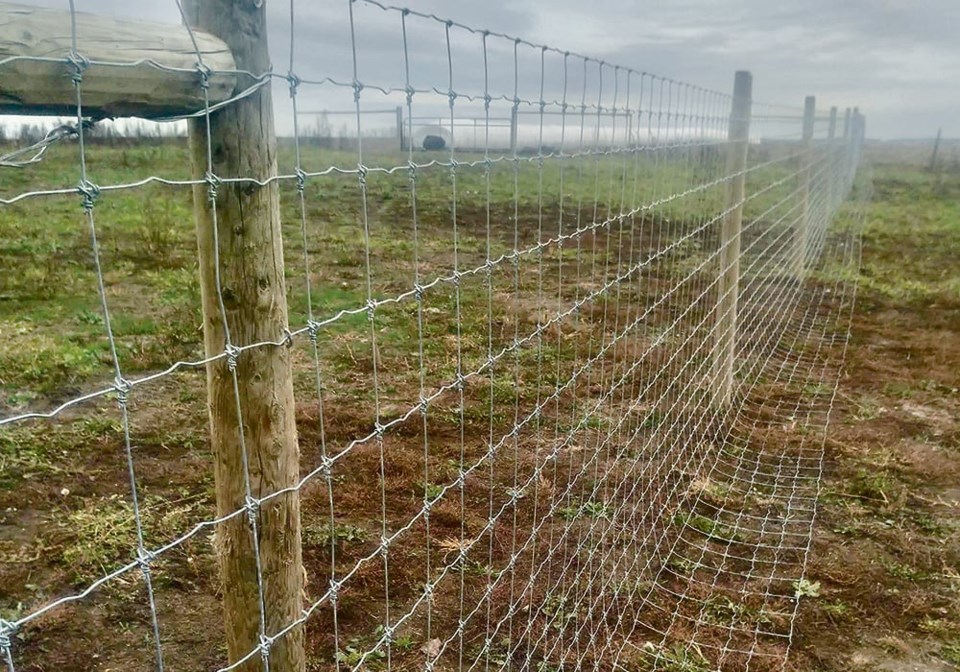WESTERN PRODUCER — Ray Bittner spends a great deal of his time thinking of ways to keep wolves away from cattle.
For the last few years, that evaluates strategies to prevent livestock predation.
During that time, he learned that wolves are difficult to defeat.
“We have a hard time working against wolves,” Bittner said in 2023.
“They are a tough foe (and) a smart foe.”
That may be true, but Bittner isn’t giving up.
Last fall he began testing a new concept to keep wolves away from cattle.
The concept is a woven-wire fence with an apron that lies on the ground to prevent wolves and coyotes from digging under the fence.
In October, Bittner helped install such fences on a couple of farms in Manitoba.
“(We’ve) built some deadstock pens and one livestock pen,” said Bittner, who raises cattle in Manitoba’s Interlake region.
It’s too early to know if the apron fences will be effective.
But results from Minnesota suggest that the rugged fencing does deter wolves and other predators.
The town of Orr, Minn., is in the northern part of the state, about 100 kilometres from the Canadian border. Rancher Wes Johnson has about 450 cows in the region north of Orr on a farm called the Sheep Ranch.
“(It’s) a cattle operation that’s in the middle of a big forested area,” said Pete Sahr, a wildlife biologist with the U.S. Department of Agriculture in northern Minnesota.
“He’s had chronic wolf (predation) problems. As an agency, we’ve trapped there every year … for many years.”
Over two decades, the USDA trapped and killed nearly 90 wolves around the ranch, the Duluth News Tribune reported in 2022.
USDA staff, along with representatives of the Voyageurs Wolf Project, approached the rancher and proposed a different way to separate the wolves and the cattle.
They convinced Johnson to give fencing a try, so they erected 14 km of woven-wire fence around the ranch.
“(But) they found in certain locations that the wolves would start digging under the fence,” Sahr said from his office in Grand Rapids, Minn.
“(So) they went around and attached that apron (at) the bottom of the fence.”
The apron fencing made the difference.
The Voyageurs Wolf Project has radio collars on a number of wolves in the region that stretches south from Voyageurs National Park on the border to Orr.
GPS data shows that the wolves are avoiding the area around the ranch.
“They can’t get in there. So, their radio collar locations show them not present in the farm (area),” Sahr said.
The USDA built a similar fence around a sheep operation in northern Minnesota.
“That’s been almost 100 percent effective. I don’t think we’ve had a (predation) there since putting in that fence,” said Sahr.
This sort of fencing is still in the experimental phase in Minnesota, he added. Livestock producers haven’t adopted the concept in other parts of the state.
However, Manitoba Agriculture staff traveled to Minnesota to learn about the fencing experiment and brought the idea to Bittner.
He needs more time to evaluate Manitoba experiments with the fencing but believes it could be an effective tool against coyotes and wolves.
“Especially in the case of deadstock, composting pens,” he said.
“If a coyote comes in there and tears at it, digs the straw up, it exposes it to oxygen. It doesn’t compost. It just rots…. It’s a better scenario having it undisturbed.”
Another use for the woven fencing with the apron could be preventing predation during calving season.
A rancher could install the fencing around one pen on the farm for cattle that are ill and more vulnerable to predators.
“If you can sort out your weaker calves and cows and put them into this pen, maybe you can save just about everybody,” Bittner said.
The downside is the cost.
“The wire alone cost us about $4 per foot,” Bittner said.
“If you compare that against steel fencing, it’s cheap. If you compare it against barb wire, it’s expensive.”
The pricey fencing is probably limited to certain situations to prevent predation.
Most wolf attacks in Manitoba, and other parts of Western Canada, happen in the summer when cattle are out on pasture, possibly long distances from the farmyard.
“(It’s) low-value land, crown land … that is closer to the wolf territory,” Bittner said.
“You are further away… There is less checking (of cattle).”
Bittner is no longer leading the livestock predation prevention project for the Manitoba Beef Producers. His term contract came to an end earlier this year.
However, the .




